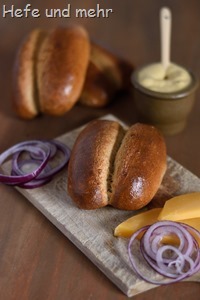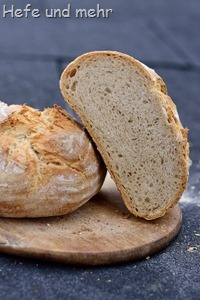 Last November a reader asked for a recipe of a moist spelt bread with high whole grain portion and different seeds. I had an idea for the bread very quickly: With a whole rye sourdough, many pumpkin seeds, some flax seeds and sesame and a good portion whole spelt flour – partly in a water roux for more moisture. But then the pysllium husk discovery happend and I changed my plan fastly. Instead of a water roux I decided to use the pysllium hulls to increase water binding. And I added some butter which makes the crumb nicely soft and helps to keep it fresh.
Last November a reader asked for a recipe of a moist spelt bread with high whole grain portion and different seeds. I had an idea for the bread very quickly: With a whole rye sourdough, many pumpkin seeds, some flax seeds and sesame and a good portion whole spelt flour – partly in a water roux for more moisture. But then the pysllium husk discovery happend and I changed my plan fastly. Instead of a water roux I decided to use the pysllium hulls to increase water binding. And I added some butter which makes the crumb nicely soft and helps to keep it fresh.
The result is a moist and aromatic bread. The crumb is full of pumpkin seeds and a thick crunchy crust. A bread with potential for a a favourite!



 The very first suggestion I got for the post series “regional bread” was East Frisian Black Bread. As I already wrote a recipe for the magazine “
The very first suggestion I got for the post series “regional bread” was East Frisian Black Bread. As I already wrote a recipe for the magazine “ The second bread for my regional bread collection is one I know well: a crusty bread from the rhineland, called “Rheinisches Krustenbrot”.
The second bread for my regional bread collection is one I know well: a crusty bread from the rhineland, called “Rheinisches Krustenbrot”. Finally I can post the first recipe in the upcoming post series of “regional breads” and can tell you how I came to this idea.
Finally I can post the first recipe in the upcoming post series of “regional breads” and can tell you how I came to this idea. I was asked more than once to publish a sourdough rye bread recipe for the “Bread baking for Beginners” post series. I hesitated as a rye bread is not so easy to handle as a wheat one and to know when a pure sourdough loaf is ready to bake needs some experience. But with the
I was asked more than once to publish a sourdough rye bread recipe for the “Bread baking for Beginners” post series. I hesitated as a rye bread is not so easy to handle as a wheat one and to know when a pure sourdough loaf is ready to bake needs some experience. But with the 
 I like recipe tweaking – especially when this happens so spontaneously like
I like recipe tweaking – especially when this happens so spontaneously like  I like to bake “by order” as I can then bake bread I bake rather seldom. Pure Rye bread, for example, as I have a rather sensitive stomach who do not like the higher acidity of rye bread. And while I do not eat rye bread I still like to bake it. Its different consistency makes it a bit challenging and is a nice change in my wheat- and spelt-dough routine.
I like to bake “by order” as I can then bake bread I bake rather seldom. Pure Rye bread, for example, as I have a rather sensitive stomach who do not like the higher acidity of rye bread. And while I do not eat rye bread I still like to bake it. Its different consistency makes it a bit challenging and is a nice change in my wheat- and spelt-dough routine.